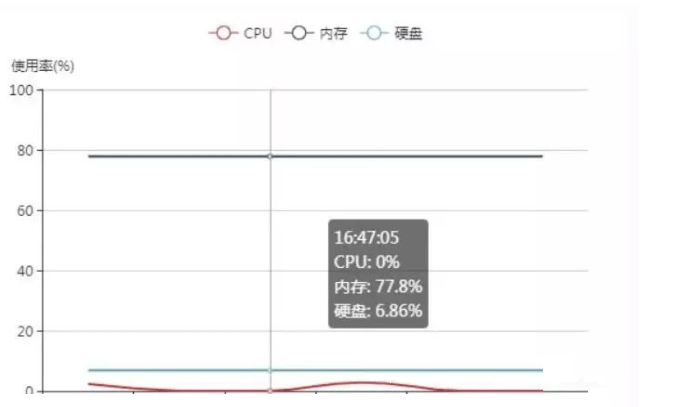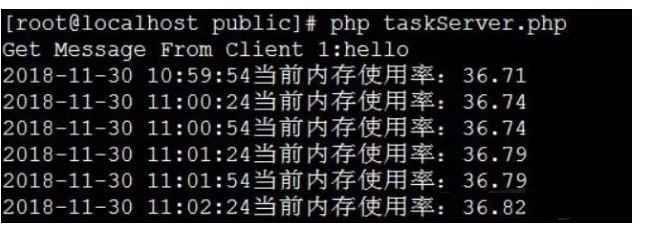项目开发中,如果有定时任务的业务要求,我们会使用linux的crontab来解决,但是它的最小粒度是分钟级别,如果要求粒度是秒级别的,甚至毫秒级别的,crontab就无法满足,值得庆幸的是swoole提供的强大的毫秒定时器。
应用场景举例
我们可能会遇到这样的场景:
场景一:每隔30秒获取一次本机内存使用率
场景二:2分钟后执行报表发送任务
场景三:每天凌晨2点钟定时请求第三方接口,如果接口有数据返回则停止任务,如果接口由于某种原因没有响应或者没有数据返回则5分钟后继续尝试请求该接口,尝试5次后仍然失败则停止该任务
以上的三个场景我们都可以归纳为定时任务的范畴。
Swoole毫秒定时器
Swoole提供了异步毫秒定时器函数:
swoole_timer_tick(int $msec, callable $callback):设置一个间隔时钟定时器,每隔$msec毫秒执行一次$callback,类似于javascript中的setInterval()。
swoole_timer_after(int $after_time_ms, mixed $callback_function):在指定的时间$after_time_ms后执行$callback_function,类似于javascript的setTimeout()。
swoole_timer_clear(int $timer_id):删除指定id的定时器,类似于javascript的clearInterval()。
解决方案
对于场景一,经常用在系统检测统计方面,实时性要求比较高,但又能控制好频率,多用于后台服务器性能监控,可以生成可视化图表。可以是30秒获取一次内存使用率,也可以是10秒,而crontab最小粒度只能设置为1分钟。
|
1
2
3
4
|
swoole_timer_tick(30000, function($timer) use ($task_id) { // 启用定时器,每30秒执行一次
$memPercent = $this->getMemoryUsage(); //计算内存使用率
echo date('Y-m-d H:i:s') . '当前内存使用率:'.$memPercent."\\n";
});
|
对于场景二,直接定义xx时间后执行某项任务的话,貌似crontab比较困难,而使用swoole的swoole_timer_after可以实现:
|
1
2
3
4
|
swoole_timer_after(120000, function() use ($str) { //2分钟后执行
$this->sendReport(); //发送报表
echo "send report, $str\\n";
});
|
对于场景三,用来作尝试请求,请求失败后继续,如果成功则停止请求。用crontab也能解决,但是比较傻,比如设置每隔5分钟请求一次,不管成功会失败都会去执行一次。而用swoole定时器则智能多了。
|
1
2
3
4
5
6
7
8
9
10
11
|
swoole_timer_tick(5*60*1000, function($timer) use ($url) { // 启用定时器,每5分钟执行一次
$rs = $this->postUrl($url);
if ($rs) {
//业务代码...
swoole_timer_clear($timer); // 停止定时器
echo date('Y-m-d H:i:s'). "请求接口任务执行成功\\n";
} else {
echo date('Y-m-d H:i:s'). "请求接口失败,5分钟后再次尝试\\n";
}
});
|
示例代码
新建文件\\src\\App\\Task.php:
|
1
2
3
4
5
6
7
8
9
10
11
12
13
14
15
16
17
18
19
20
21
22
23
24
25
26
27
28
29
30
31
32
33
34
35
36
37
38
39
40
41
42
43
44
45
46
47
48
49
50
51
52
53
54
55
56
57
58
59
60
61
62
63
64
65
66
67
68
69
70
71
72
73
74
75
76
77
78
79
80
81
82
83
84
85
86
87
88
89
90
91
92
93
94
95
96
97
98
99
100
101
102
103
104
105
106
107
108
109
110
111
112
113
114
115
116
117
118
119
120
121
122
123
124
125
126
127
128
129
130
131
132
|
namespace Helloweba\\Swoole;
use swoole_server;
/**
* 任务调度
*/
class Task
{
protected $serv;
protected $host = '127.0.0.1';
protected $port = 9506;
// 进程名称
protected $taskName = 'swooleTask';
// PID路径
protected $pidPath = '/run/swooletask.pid';
// 设置运行时参数
protected $options = [
'worker_num' => 4, //worker进程数,一般设置为CPU数的1-4倍
'daemonize' => true, //启用守护进程
'log_file' => '/data/log/swoole-task.log', //指定swoole错误日志文件
'log_level' => 0, //日志级别 范围是0-5,0-DEBUG,1-TRACE,2-INFO,3-NOTICE,4-WARNING,5-ERROR
'dispatch_mode' => 1, //数据包分发策略,1-轮询模式
'task_worker_num' => 4, //task进程的数量
'task_ipc_mode' => 3, //使用消息队列通信,并设置为争抢模式
];
public function __construct($options = [])
{
date_default_timezone_set('PRC');
// 构建Server对象,监听127.0.0.1:9506端口
$this->serv = new swoole_server($this->host, $this->port);
if (!empty($options)) {
$this->options = array_merge($this->options, $options);
}
$this->serv->set($this->options);
// 注册事件
$this->serv->on('Start', [$this, 'onStart']);
$this->serv->on('Connect', [$this, 'onConnect']);
$this->serv->on('Receive', [$this, 'onReceive']);
$this->serv->on('Task', [$this, 'onTask']);
$this->serv->on('Finish', [$this, 'onFinish']);
$this->serv->on('Close', [$this, 'onClose']);
}
public function start()
{
// Run worker
$this->serv->start();
}
public function onStart($serv)
{
// 设置进程名
cli_set_process_title($this->taskName);
//记录进程id,脚本实现自动重启
$pid = "{$serv->master_pid}\\\\n{$serv->manager_pid}";
file_put_contents($this->pidPath, $pid);
}
//监听连接进入事件
public function onConnect($serv, $fd, $from_id)
{
$serv->send( $fd, "Hello {$fd}!" );
}
// 监听数据接收事件
public function onReceive(swoole_server $serv, $fd, $from_id, $data)
{
echo "Get Message From Client {$fd}:{$data}\\n";
//$this->writeLog('接收客户端参数:'.$fd .'-'.$data);
$res['result'] = 'success';
$serv->send($fd, json_encode($res)); // 同步返回消息给客户端
$serv->task($data); // 执行异步任务
}
/**
* @param $serv swoole_server swoole_server对象
* @param $task_id int 任务id
* @param $from\\id int 投递任务的worker_id
* @param $data string 投递的数据
*/
public function onTask(swoole_server $serv, $task_id, $from_id, $data)
{
swoole_timer_tick(30000, function($timer) use ($task_id) { // 启用定时器,每30秒执行一次
$memPercent = $this->getMemoryUsage();
echo date('Y-m-d H:i:s') . '当前内存使用率:'.$memPercent."\\n";
});
}
/**
* @param $serv swoole_server swoole_server对象
* @param $task_id int 任务id
* @param $data string 任务返回的数据
*/
public function onFinish(swoole_server $serv, $task_id, $data)
{
//
}
// 监听连接关闭事件
public function onClose($serv, $fd, $from_id) {
echo "Client {$fd} close connection\\n";
}
public function stop()
{
$this->serv->stop();
}
private function getMemoryUsage()
{
// MEMORY
if (false === ($str = @file("/proc/meminfo"))) return false;
$str = implode("", $str);
preg_match_all("/MemTotal\\s{0,}\\:+\\s{0,}([\\d\\.]+).+?MemFree\\s{0,}\\:+\\s{0,}([\\d\\.]+).+?Cached\\s{0,}\\:+\\s{0,}([\\d\\.]+).+?SwapTotal\\s{0,}\\:+\\s{0,}([\\d\\.]+).+?SwapFree\\s{0,}\\:+\\s{0,}([\\d\\.]+)/s", $str, $buf);
//preg_match_all("/Buffers\\s{0,}\\:+\\s{0,}([\\d\\.]+)/s", $str, $buffers);
$memTotal = round($buf[1][0]/1024, 2);
$memFree = round($buf[2][0]/1024, 2);
$memUsed = $memTotal - $memFree;
$memPercent = (floatval($memTotal)!=0) ? round($memUsed/$memTotal*100,2):0;
return $memPercent;
}
}
|
我们以场景一为例,在onTask启用定时任务,每隔30秒计算一次内存使用率。实际应用中可以把计算好的内存按时间写入数据库等存储中,然后可以根据前端需求用来渲染成统计图表,如:
接着服务端代码 public\\taskServer.php :
|
1
2
3
4
5
6
7
8
|
<?php
require dirname(__DIR__) . '/vendor/autoload.php';
use Helloweba\\Swoole\\Task;
$opt = [
'daemonize' => false
];
$ser = new Task($opt);
$ser->start();
|
客户端代码 public\\taskClient.php :
|
1
2
3
4
5
6
7
8
9
10
11
12
13
14
15
16
17
18
19
20
|
<?php
class Client
{
private $client;
public function __construct() {
$this->client = new swoole_client(SWOOLE_SOCK_TCP);
}
public function connect() {
if( !$this->client->connect("127.0.0.1", 9506 , 1) ) {
echo "Error: {$this->client->errMsg}[{$this->client->errCode}]\\n";
}
fwrite(STDOUT, "请输入消息 Please input msg:");
$msg = trim(fgets(STDIN));
$this->client->send( $msg );
$message = $this->client->recv();
echo "Get Message From Server:{$message}\\n";
}
}
$client = new Client();
$client->connect();
|
验证效果
1.启动服务端:
|
1
|
php taskServer.php
|
2.客户端输入:
另开命令行窗口,执行
|
1
|
[root@localhost public]# php taskClient.php
|
请输入消息 Please input msg:hello
|
1
2
|
Get Message From Server:{"result":"success"}
[root@localhost public]#
|
3.服务端返回:
如果返回上图中的结果,则定时任务正常运行,我们会发现每隔30秒会输出一条信息。
总结
到此这篇关于php使用Swoole实现毫秒级定时任务的方法的文章就介绍到这了,更多相关php Swoole实现毫秒级定时任务内容请搜索快网idc以前的文章或继续浏览下面的相关文章希望大家以后多多支持快网idc!
原文链接:https://www.cnblogs.com/it-abu/archive/2020/09/03/13610746.html
相关文章
- 64M VPS建站:怎样选择合适的域名和SSL证书? 2025-06-10
- 64M VPS建站:怎样优化以提高网站加载速度? 2025-06-10
- 64M VPS建站:是否适合初学者操作和管理? 2025-06-10
- ASP.NET自助建站系统中的用户注册和登录功能定制方法 2025-06-10
- ASP.NET自助建站系统的域名绑定与解析教程 2025-06-10
- 2025-07-10 怎样使用阿里云的安全工具进行服务器漏洞扫描和修复?
- 2025-07-10 怎样使用命令行工具优化Linux云服务器的Ping性能?
- 2025-07-10 怎样使用Xshell连接华为云服务器,实现高效远程管理?
- 2025-07-10 怎样利用云服务器D盘搭建稳定、高效的网站托管环境?
- 2025-07-10 怎样使用阿里云的安全组功能来增强服务器防火墙的安全性?
快网idc优惠网
QQ交流群
-
2025-06-04 72
-
2025-06-04 64
-
2025-05-25 25
-
2025-05-25 34
-
2025-05-29 91












